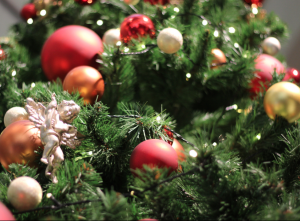The calendar warns that we have less than two weeks until Christmas. Before your days are totally taken over by shopping, decorating and festive gatherings, spend a few minutes to ensure a safe and enjoyable holiday season.
Remember that live Christmas trees, lit candles, roaring fireplaces, and strands of electric lights heighten the threat of house fires. Small toys and decorations present choking hazards for children. And some holiday plants can sicken or kill household pets (with poinsettias among the least of your worries).
FIRE PREVENTION
Safety experts warn that house-fire dangers peak from Thanksgiving through New Year’s Day.
If you’re buying a cut Christmas tree, check for freshness. If you get an artificial tree, look for the words “fire resistant” on the label.
Place all trees away from fireplaces, radiators, and other heat sources.
You’ve heard it before, but it bears repeating: Water cut Christmas trees regularly. Why? Check out this video of two trees set on fire. The dry tree literally explodes in flame; the watered tree survives almost intact.
Keep burning candles within sight at all times, and at least 12 inches from anything that can ignite. Extinguish all candles before you go to bed, leave the room, or vacate the house. A Web page from the National Fire Protection Association offers sensible tips on burning decorative or religious candles.
Before using holiday lights outdoors, check labels to make sure they have been certified for outside use.
Never mount lights in any way that can damage the cord’s wire insulation. To hold lights in place, string them through hooks or insulated staples — don’t use nails or tacks.
Before lighting a fireplace fire, remove all greens, boughs, papers, and other decorations from the area.
Don’t burn wrapping paper in the fireplace; it can ignite suddenly and cause a flash fire.
DECORATING DANGERS
Never use electric lights on metallic trees. The tree can become charged with electricity from faulty lights, and a person touching a branch could be electrocuted.
“Fire salts” produce colored flames when thrown on wood fires, but they contain heavy metals that can cause intense gastrointestinal irritation and vomiting if accidentally swallowed.
Artificial snow sprays can irritate the lungs if inhaled. Follow directions carefully.
Ladder-related injuries spike during December; take extra care when climbing on ladders to hang decorations and lights. And before you do, check out the Ladder Safety 101 page from the U.S. Consumer Product Safety Commission (CPSC).
CHILD SAFETY
Check the CPSC’s recall database to make sure your child’s new toys have not been recalled. A search for “toys” will reveal dozens of recalls in just the last few months. Check the list regularly.
Small toys and decorations can be choking hazards, even those that meet federal safety standards.
Gift bags, wrapping paper, ribbons, and bows can pose suffocation, strangulation, and choking hazards to a small child.
PET SAFETY
Contrary to popular belief, poinsettias are only mildly poisonous to cats and dogs. Holly is far more dangerous; when ingested, it can cause pets to suffer nausea, vomiting, and diarrhea. Mistletoe can cause gastrointestinal upset and cardiovascular problems. Just one or two bites of a lily can result in severe acute kidney failure in cats.
Check out the American Society for the Prevention of Cruelty to Animals’ Holiday Safety Tips page for more pet-friendly advice.
LEARN FROM THE EXPERTS
Looking for more good advice? The CPSC’s website has a downloadable holiday decorating guide and a roundup of holiday-season home-safety tips. Also, check out the website of the International Association of Certified Home Inspectors.
(Image: Flickr/Zaimoku_woodpile)
